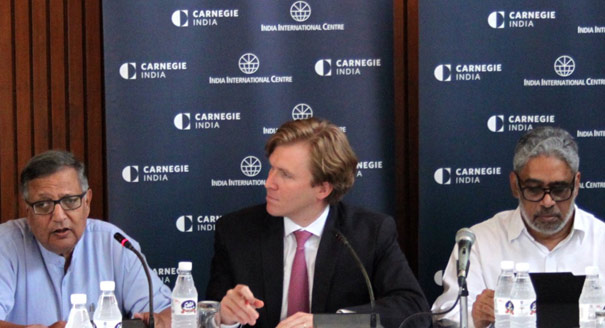Carnegie India, in collaboration with the India International Centre, New Delhi, hosted a roundtable discussion on China’s growing force projection capabilities and their implications for the United States and India. The roundtable brought together a number of scholars and practitioners interested in the triangular dynamic between India, China, and the United States. The participants examined the rapid rise of China and the unprecedented steps that the United States and India will have to take to develop a strategy of balancing without containing China.
Elbridge Colby, the Robert M. Gates Senior Fellow at the Center for a New American Security, led the roundtable discussion. It was moderated by Brigadier Arun Sahgal (retd.), executive director of the Forum for Strategic Initiative, a policy think tank focused on national security, diplomacy, and Track II dialogues.
Discussion Highlights
- Chinese Power Projection Capabilities: In 2015, the Chinese People’s Liberation Army (PLA) began its eleventh major reorganization since 1952. Participants argued that as Chinese capabilities have increased, their ambitions have also evolved. The first public Chinese Military Strategy White Paper demonstrates a changed conception of Beijing’s outward ambitions and interest in effectively expanding the country’s regional footprint. Significantly, participants added, this is accompanied by a real capacity to project power.
- Strategic Posture: Participants emphasized that there has been a fundamental shift in China’s strategic posture. China’s ability to shield potential threats to any of its core interests has been buttressed by a rapid and discernable escalation in its military capacity building—from the development of amphibious capabilities to marked improvements in the sophistication of its nuclear technology and new systems of refueling and replenishment in the high seas.
- U.S. Interests: Given U.S. interests in the maritime Asia-Pacific region, participants agreed that the United States is likely to remain engaged in region, regardless of the political constellation that emerges from the 2016 U.S. presidential elections. Participants argued that the United States and countries in the region must balance China’s growing assertiveness so it is not emboldened to dictate new rules of the game. They added that, given China’s increasingly abilities, any advantages held by the United States in the South China Sea were vulnerable and susceptible to further erosion.
- Defense Cooperation: Maintaining a balance will require sharing the burden among regional powers, participants said. Even if all of China’s current pipeline projects are realized, 53 percent of their oil will still transit through the Indian Ocean. Participants felt that the Indian Ocean was a logical area for cooperation between the United States and India, given their common interest in convincing China of the wisdom of prudent strategic thinking. This would call for deeper defense cooperation, technology transfers, and intelligence sharing. They added that the Indian government would need reassurances from Washington that they would refrain from providing shared technologies to other players who may be adversaries of India.
- U.S. Role in the Region: Some participants expressed doubts about the willingness of the United States to enable allies to do more to bolster the local balance. Participants emphasized that China has penetrated the Indian sphere of influence by neutralizing neighboring constituencies, which has effectively reduced India’s capacity to limit Chinese political and economic influence. They pointed out that the Chinese, on their part, have also attempted to fundamentally weaken American political alliances by raising doubts about the credibility and durability of American political commitment.
- Third Offset Strategy: Participants felt that the U.S. Third Offset Strategy could be a potential area of cooperation with allies. This strategy, which envisages maintaining a technological edge over adversaries through the development of next-generation power projection platforms—like unmanned autonomous weapon systems—would be crucial to reinforce partner capabilities. While some participants felt that this would demonstrate American commitment to working together, others noted that technological superiority is critical to the U.S. military and Washington might be hesitant to share such technology. There was consensus that the U.S. Congress must be convinced of the need to forge strong alliances with sovereign nations they can trust and partner with.
- Limited War and Escalation Management: Participants expressed their concerns on commingling, referring to reports of Pakistani and Chinese assets with dual capability. They agreed that this issue was likely to gain importance as policy is formulated on limited war and escalation management. Some felt that forces should be separated, as commingled forces could be legitimate targets of attack. This would set an expectation that commingled forces are not protected. Participants agreed that the United States and India needed to jointly analyze deterrence failures in Asia to comprehend how escalation management would be played out in the Asia-Pacific and if there would be collaborative power in those conflicts.
This event summary was prepared by Arushi Kumar, a research assistant at Carnegie India.
